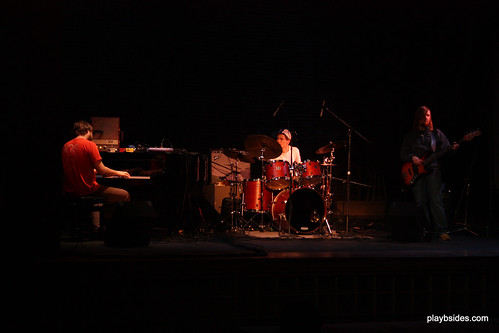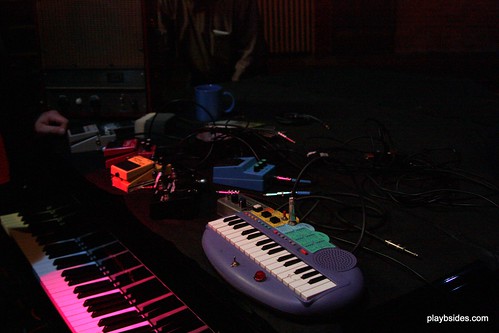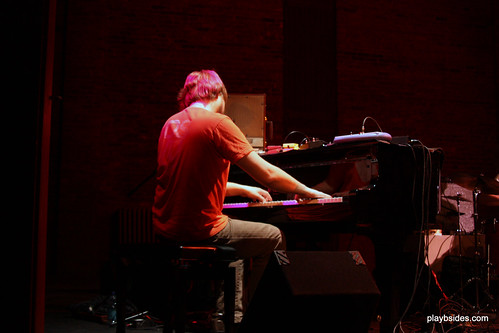On Easter Sunday evening, April 12th, Marco Benevento performed at CSPS in Cedar Rapids in his trio with Reed Mathis on bass and Simon Lott on drums. The tour was in support of Marco’s latest solo release Me Not Me, which is also his second solo release. Sunday night was the last night on a brief tour that included stops in Chicago, Des Moines, and Minneapolis. Unfortunately, a mixup about the show start time had me miss the first of two sets. Apparently shows at CSPS start an hour earlier on Sunday nights (note to self!). I wasn’t aware of Marco’s fairly extensive career leading up to his latest release, but I had been giving Me Not Me pretty heavy rotation leading up to the show. Me Not Me is a collection of original songs and an insteresting and eclectic selection of covers from artists as wide-ranging as Leonard Cohen and Led Zeppelin to My Morning Jacket and Deerhoof.
The second set started with “Atari” and was followed by “Twin Killers” and a really smart “Mephisto” that ended with an impromptu vamp of Jane’s Addiction’s “Summertime Rolls.” It was clear that the trio was in rare form and were having a really good time on stage and probably looking to wrap up the tour on a high note. After the show was over, I got the opportunity to sit down with Marco and talk a bit about his music. Marco was a fun and very laid-back interview. He’s a guy who has very specific ideas about his art and it was a very enlightening conversation. I followed Marco and the guys back to their hotel so they could get checked in, and Marco and I sat in the lobby for the interview while they waited for the hotel shuttle to take them to dinner.
playbsides: Prior to Me Not Me, I hadn’t heard any of your albums and I wasn’t sure what to expect with the album based on the descriptions online. Your combination of piano jazz and indie rock sensibilities is very unique, but there was something about the piano parts that I completely latched on to. Parts of it remind me of my favorite classic jazz piano from guys like Vince Guaraldi, Dave Brubeck or Bill Evans– I’m not sure I can put my finger on it. It isn’t like Bill Evans covered My Morning Jacket!
Marco: Maybe it is the “pop” sensibility– if I may go so far as to say that.. The Bill Evans stuff– even the way he voiced the melodies– like “Waltz for Debbie” for example is almost a pop sensibility. Like, the focus on the melody and the chords underneath it– yeah.
There is a gray area there. There is a line between the rock and jazz pianists– like the George Winston and the Bill Evans– there is a line that is sort of thickening and widening and becoming this gray area and a lot of pianists are landing in there– like EST, you know Esbjörn Svensson Trio— check them out a really cool trio– the use effects on the drums and the bass. The piano player is incredible… actually he just passed away– a freak scuba diving accident.
While doing some research trying to get caught up on your career, I noticed that it seems that a lot of people represent you as this “jam band” pianist. But, my observation watching the show tonight was that you are taking the traditional jazz piano trio and kind of flipping it on its side a bit with the circuit bent toys and in the same fashion that the great jazz trios were performing “standards” and putting their improv on it, you are taking newer songs and doing a similar thing.
Yeah, it’s definitely based on tradition, you know and playing other people’s songs– the pop music of the day and doing what you want to it– whether it be rearranging it or soloing over it or producing it in this cool way– overdubbing stuff on it.
At first blush it could seem like the circuit bent toys could be perceived as “gimmicky” but it’s clear from tonight’s show– when you don’t turn that stuff on– your trio has the chops!
Yeah, there is definitely the musicality there. We said that even tonight. Simon said, “Yeah there are so many options, there are so many different places you guys can go– we could stay in like a Creedence Clearwater type jam– a funky sort of thing, or we could go into a sort of psychedelic “free” section, we could go into odd meter. Interplay– kind of a jazz harmony, soloing– where we take turns soloing– that’s also in other music, like Rock, too. But, yeah it’s really fun to do– to really connect with the audience like that, because when they here a tune they know from another band it really draws them in more because they can relate to it.
Yeah, like with your version of “Friends” by Led Zeppelin, you pull the main hooks from the song, but the rest of the song is completely different and new. Yeah, it’s like the way that Miles Davis covered “Guinnevere” by Crosby Stills and Nash, have you hear that one?
No!
[Davis’s 18-minute take on “Guinnevere” was recorded in 1970 during the sessions that would be used on Big Fun, and released on a compilation called Circle in the Round that was originally released in 1979 and is currently out-of-print. -ed]
It’s killer. I need to dig that out again– I haven’t heard it in a long time! It’s cool to hear other people’s interpretation of a song, like if it’s really minimalistic, stripped down approach, and it becomes a completely different song, “I don’t even recognize that song at all!” It’s like Brad Mehldau— the way he does “50 Ways to Leave Your Lover” the Paul Simon song. Have you heard that?
I know the Paul Simon song, but not Brad Mehldau’s version.
It is this incredible improv over some changes– they get really experimental for a while and then by the end of the tune– if my memory serves me right– they just play the melody– and then that’s it! It’s like this really long thing, and you’re like “what’s going on?” and then it’s in seven– this completely other time signature– then they just do the melody [sings] “it’s 50 ways to leave your lover” and then it ends!
I guess you need to bring it back around, huh?
Well, they didn’t even start there! (laughs)
I’ve covered “50 Ways to Leave Your Lover, too.” I went to Brad Mehldau’s house, actually, and got a lesson with him. I sat down at his piano, and he was just doing some stuff in the kitchen, and he’s like “ah, just go sit down!” I was psyched to be there, you know? I sat down at the piano and there was a sheet of paper at the piano, and I’m like “I wonder what he’s working on?” I had been playing a lot with Joe Russo (of the Benevento Russo Duo) and we had been covering “50 Ways to Leave Your Lover” actually for a while as part of our set– so I look up at the sheet of paper on his pianio and it says “50 Ways to Leave Your Lover.” So he comes back and tell him that I play “50 Ways to Leave Your Lover” and he’s like, “How do you play it” and I’m like “we play it pretty straight” and he says that he wants to play it with his trio. It’s so funny when someone comes up with the same idea you have– you know, when like an idea drifts through everybody.
It seems that the choices of covers on Me Not Me really run the gamut, how did you arrive at the covers you chose?
A lot of them we favorite songs, really. Like the My Morning Jacket song– the first time I heard it I was driving– I think it was somewhere around the Midwest– it was just a perfect song at a perfect time. I’d actually wanted to make a record of covers for a long time. The idea came to me in 2000 when I moved to New York, and it is finally coming out now. It didn’t take us long to record the album, but a lot of the covers I’d been playing for a while, like the Leonard Cohen cover I’ve been playing since 2000. We took two days to track it, and then I took it home and overdubbed some stuff on it.
Speaking of covers, I like your version of “She’s Not There” by the Zombies.
A lot of the songs we cover are songs that move me. The way we play “She’s Not There” harmonically is how the song appeared in Quentin Tarantino’s Kill Bill volume 2. It was a piece done by some DJ that used samples of “She’s Not there”– so our version is actually a cover of a cover.
[This is “About Her” by Malcolm McLaren -ed]
Coincidentally, the Zombies are back together and will be performing a concert of Odessey and Oracle along with some other music by Rod Argent like “Hold Your Head Up” its an anniversary of that album.
[The 40th Anniversary shows took place in the UK in April -ed]. Oh, really? That’s cool! So, do you ever get concerned that you’ll get pigeonholed as doing covers?
No, I like doing covers. They’re gorgeous songs and I like playing them. Of course, I like playing my own original music, too! So, no I think it’s a great way to connect to people, because it makes them want to check it out even more, right? I like to shake it up, though. Some shows will be mostly original songs, with maybe one cover. It also depends on how long the show is, if we need to stretch it out. I did have a moment when I was editing the album when it hit me– “Wow, these are all cover tunes.” I’m glad I have the three songs I do have on there of my own. But, it’s really inspired me to write more other music and not spend as much time searching for covers. I’ve been writing a lot of more upbeat almost electronic sort of circuit-bent poppy sounding stuff. We played one tonight.
What is that track called?
It’s now called “Greenpoint” we included it on the bonus disc that we included if you did the pre-order– there was a live version of it on there. It’s a new way of composing music for me– more loopy, repetitive almost monochromatic.
I like how you’re using the circuit bent stuff as an extra element to what you’re doing rather than the main element. While I can appreciate what some musicians are doing with circuit-bent–
It’s a wild horse, you know, and it’s hard to ride. If you don’t have a volume pedal, or delay or a way to really finesse it when using it live some times it comes off as a mess. When I first started using it– a couple of times it just was not musical. But, over time, I figured out how to bring it in here and there– otherwise it becomes this blanket that is way too thick.
You’re using it as kind of a way to color the music.
Right. It also ends up adding another section to a song.
For me anyway, some of the circuit bent music out there I really can’t get into. I guess, at the end of the day, I really need something to hang my attention on – there needs to either be a strong beat, or there’d better be a melody. Sometimes it gets a little difficult to swim through those waters.
(laughs) Right, right. And variety for me is important in a show otherwise it gets to be too one-dimensional. It’s important to have these moments in the songs where you can freak out to get into this different color for a second. But sometimes it can get to be almost an indulgence– like you might want to alienate yourself from the audience when my whole thing as a musician is about entertainment. People actually left their house to come here so I don’t want to burden them with anything… they’ve got to escape, you know? It’s important for a listener to just lose it. And then, in order for them to lose it you have to give them something to grab their attention– some melody, some simple chord changes. But also music that grabs myself. When I watch someone else play, I really like it when I can tell that they really love what their doing, first of all– and, you know when your a kid and you’re in church and everything seems funny that you can’t stop laughing– that feeling that “this is SO much fun!”
It’s funny that you mention that. Earlier, Simon came out with this grin on his face, and I asked him, “What are you smiling about?” He said, “Nothing, it is just really great to play these songs!”
At that point, the driver showed up and Reed, Simon and Marco wanted to get some food, so I let them head out after thanking Marco for taking the time to talk to me.
Recently Amazon listed its 100 Greatest Jazz albums of all time list, and maybe not surprisingly the majority of the albums were from the halcyon jazz years of the 50’s and 60’s. This lack of more recent releases was a criticism of the list. Why, for example, does Kind of Blue— an album recorded over 50 years ago– continually show up as the best? Many of the releases on the list were groundbreaking at the time, but certainly stood the test of time to become standards. When I look at current jazz, most of it is derivative of different periods of jazz history. I’m not suggesting that Marco’s new album will stand next to Kind of Blue as a classic, but it is the mix of his unique approach to his music while recognizing the jazz tradition that would seem to me to be the right formula for longevity.
Click Here to visit Marco Benevento’s website
Click Here to visit Marco Benevento’s MySpace Page
Here are the photos from the 4/12/09 show at CSPS in Cedar Rapids, IA.






